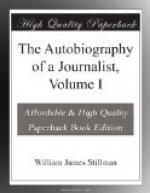Another acquaintance made in these days, which has always remained a delight to me, was that of Theodore Rousseau, to my mind the greatest of the French landscape painters. Though living and working mostly at Barbison, he had a studio in Paris, and there I used to see him, always received in the friendly and helpful way which was characteristic of most of the French artists of the higher order. Later I went to Barbison, where, besides Rousseau, I knew J.F. Millet, and a minor, but in his way a very remarkable, painter, Charles Jacque. Rousseau was a most instructive talker on art, beyond the sphere of which he hardly seemed to care to go in his thinking. He had never been out of France, had never seen the Alps, and did not care for mountain scenery, but concentrated all his feelings and labor on what he used to call “sujets intimes,” the picturesque nooks of landscape one can always find in a highly cultivated country, where nature is tamed to an intimacy with the domestic spirit, or where she vainly struggles against the invasion of culture, as in the borders of the forest of Fontainebleau. In such material, nature withdraws farther and makes a wider margin for art, and the wedding and welding of the two become more subtle and playful.
It has always seemed to me that with all the differences inherent in the antagonism of the characters of the two men, the essential features of the art of Rousseau and Turner were the same; pure impressionism based on the most intimate and largest knowledge of the facts of nature, but without direct copying of them—rather working from memoranda or memories, for neither ever painted directly from nature; the same conception of the subject as a whole, its rhythmic and harmonic unity as opposed to the fragmentary manner of treatment of most of their contemporaries; the lyric passion in line and tint; the same originality which often became waywardness in the conception of subject in itself; the same revolt from all precedent; and the same passion for subtle gradation and infinite space, air, and light—and some of Rousseau’s skies were the most vaporous I have ever seen. These are the fundamental agreements of the art of the two great masters, and in those qualities no other man of their countries and epoch has equaled them, but outside of these the contrasts are of the most pronounced. Pyne told me that Turner said he wished he could do without trees; Rousseau worshiped them. Turner loved the mountains; Rousseau never cared to see them and never painted one. Turner, a colorist, reveled in color like a Bacchanal; Rousseau, a tonalist, felt it like a vestal; but both had the sense of color in the subtlest refinement.




